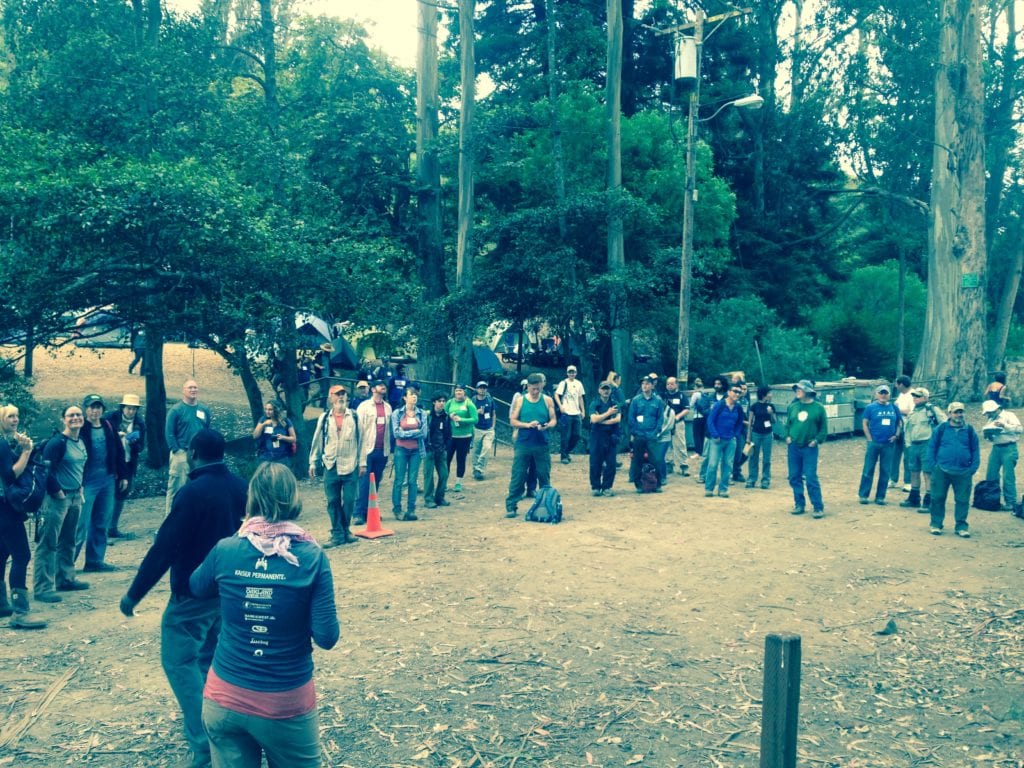
Story and photos by Murray Schneider
On the Wednesday before the July 17-19 weekend —- before Volunteers for Outdoor California workers bivouacked in 35 tents by Glen Canyon’s Silver Tree Day Camp in preparation for three days of trail work —- Jenny Sotelo, Recreation and Park’s Natural Areas Program gardener, led five members of Friends of Glen Canyon Park along the southern-most end of the recently-named Coyote Crags Trail.
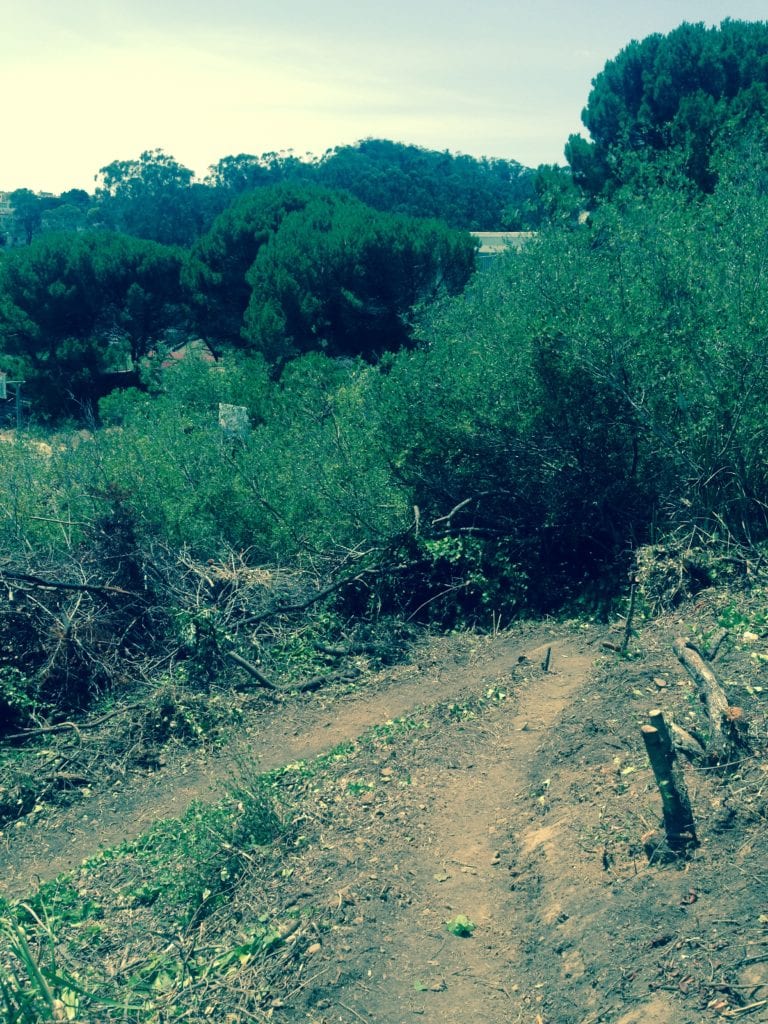
Sotelo’s neighborhood work party pulled invasive mustard that doted the narrow path’s edges.
“We want to remove the mustard three feet above the trail,” Solelo told her team, “so Volunteers for Outdoor California can widen it this weekend.”
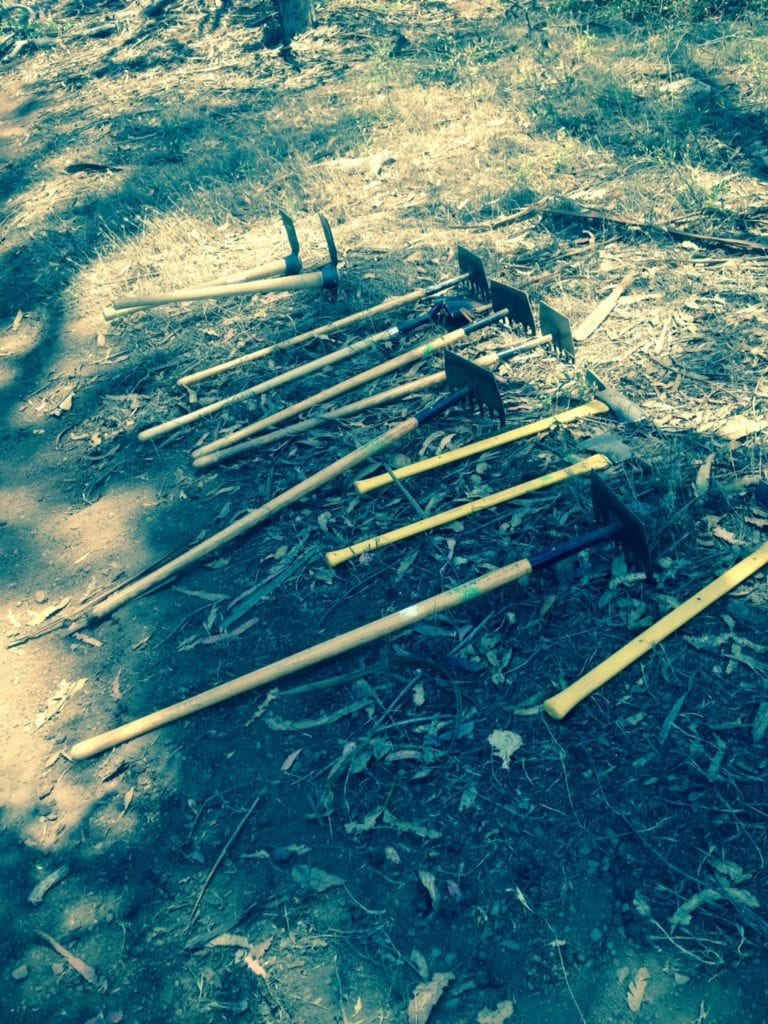
Single file, neighbors who live on Chenery and Laidley Street, Stillings Avenue and Monterey Boulevard leapfrogged by one another, collecting mustard and stuffing it into green pop-up bags. They traversed a narrow trail dwarfed by Franciscan rock outcrops. Each negotiated a path shadowed by grassland that eventually segued into coastal shrubs. Not in seed, they sacrificed the mustard stalks far off trail, continuing on, refilling their bags.
Their preparatory work would by more than matched by the weekend efforts of 125 V-O-Cal volunteers, who labored over three days to complete most of Parks Bond-funded Glen Canyon Trails Improvement Project. Working with tools used to combat California wild fires, 12 different V-O-Cal crews wielded Pulaski axes and McLeod brush hoes in the service of widening trail “bench,” camouflaging gerrymandered social paths, pushing back Cape ivy and Himalayan blackberry, pruning willow limbs, repairing drain dips, and, all the while, avoiding poison oak.
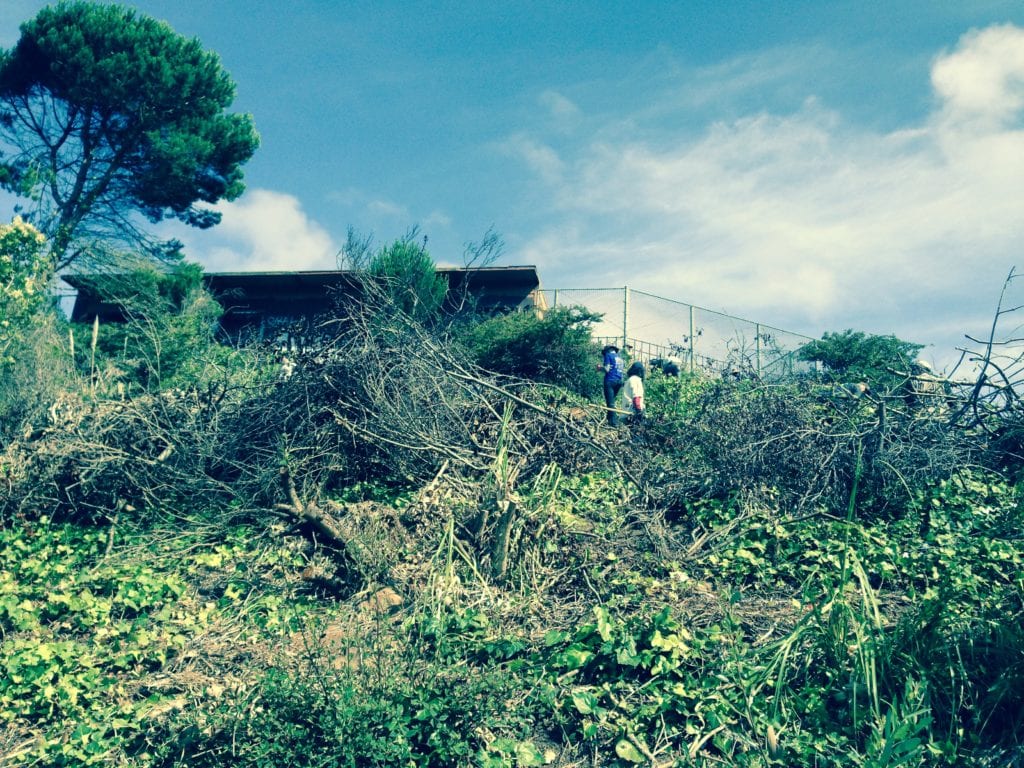
After the first full day of work volunteers retreated to their Silver Tree overnight campsite. There they sipped beer and wine and munched on cold grapes and watermelon slices. Others relaxed in front of tents, Islias Creek in front of them, dormant and silent.
Cathy Moyer, the V-O-Cal Executive Director stood before several boiling pots, adopting the role of chief chef for the evening.
She pointed to what appeared to be four teepee-shaped tents, but weren’t.
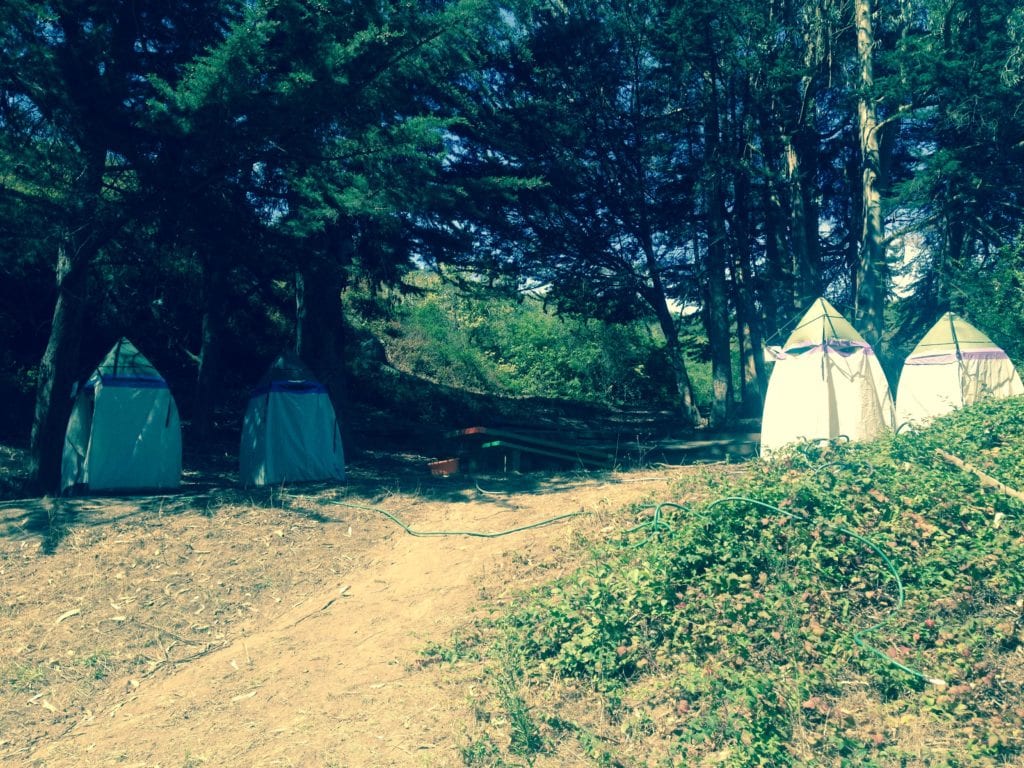
“Those are shower tents,” she said. “We use precious little water, but want the volunteers to wash away poison oak oils.”
“We have a great working relationship with the Natural Areas Program,” she added, ladling the bubbling water, ready to receive cubes of chicken for a Thai-curry dish she intended to serve hungry volunteers.
Surveying the exhausted volunteers, she offered: “This is as much about people coming together to forge community as it is about the stewardship of the landscape.”
Earlier, General Manager of San Francisco Rec & Park, Phil Ginsburg, weighed in: “Volunteers for Outdoor California is one of our premier volunteer groups that goes above and beyond taking ownership of their park. We’re lucky to have this partnership with them over the last 10 years and are pleased to give them the opportunity to camp out in the place where they’ve done so much work.”
And work they did, canvassing the entire 70-acre canyon trail network, working on trail bed/corridor paths that Ginsburg and his staff have dubbed the “Creeks to Peaks Trail.”
“I call it ‘sweat equity,’” said Cathy Moyer.
By first day’s end on July 18 there was plenty of perspiration.
Earlier, at 8 a.m., the volunteers had assembled, greeted by San Franciscan Inome Callahan, the weekend project leader, herself a veteran of 20 previous V-O-Cal projects, eight of which have been with San Francisco’s Rec and Park Department.
“It’s very satisfying to be able to give back to our community and its fun to boot,” Callahan said. “I love the camaraderie, feeling proud of the trails I’ve worked on and feeling I’ve made a difference.”
Callahan led the volunteers in some warm-up calisthenics. Lisa Wayne, the Natural Areas Program manager and her cadre of NAP gardeners, joined them. Each would assist and supervise one of the V-O-Cal crews.
Given their marching orders, the different crews set off, fanning out along three recently-named trails; the Islias Creek, Gum Tree Girls and Coyote Crags trails. Carrying tools, they walked by earlier-placed entrance maps, interpretive signs, and singular posts at key trail intersections mounted with small way finding placards. Retaining walls and guardrails greeted them, and always looming to their east were the nearly 200 box steps installed by Yerba Buena Engineering and Construction.
NAP gardener Dylan Hayes, accompanied by Melinda Stockmann, RPD Project Manager of the Trails Improvement Program, led one crew. Along the way, Hayes explained the task, how using their forestry tools they’d fashion an intuitive three-foot trail, widening each side of the path by bushing back blackberry and willow from the path edge and cleaving edges of existing trail backside.
Hayes pointed to an embedded rock, which could double as a natural bench to accommodate recreational day-trippers once the vegetation was pushed back.
“Let’s try and embellish this as a bench,” he said.
Sunlight eased lazily through a canopy of arroyo willow, giving the trail a cathedral glow.
“We want to keep the sanctuary feel,” Hayes said.
Next to Hayes, another crew worked near the stringer steps that lead to the Saddle Trail, sandwiched between two chert outcrops. Francesca Verdier —- who camped in the canyon in 2013 when she’d worked on the V-O-Cal Twin Peaks trail system project and who lives in Berkeley —- leaned on a tamper, a tool used to flatten and compact soil.
“There have been so many improvements since I was last here,” she said. “So many more steps and a new playground. San Francisco should be proud it put so much effort in its parks.”
Ahead of Hayes and Verdier’s crew the trail doglegged to the right, then angled acutely again, heading north. Beneath Turquoise Way houses balanced on stanchions, another corps of volunteers sculpted a new trail that eventually led to a recently finished bridge. Across it, for the first time, stood San Francisco Unified School District property. As others had, this crew widened the trail by the length of a forest fighting Pulaski, a tool whose head combines both an axe and an adze. In the distance, notes from a three-member brass band, imported to entertain the volunteers, wafted across the scrubland.
Led by crew chief Elissa Goldner, who lives in Hayes Valley, the team worked as temperatures topped an unseasonable 73 degrees, and would skyrocket 14 degrees by the following day.
Volunteer Cassandra Van Dyne, who’d come all the way from Napa, wielded a pick mattock on this her third V-O-Cal project. Van Dyne is in a university teaching credential program and presently oversees a mentoring program for middle school students at Calistoga Junior and Senior High School. She’s training to become a mathematics teacher.
Pausing, she studied a trio of rocks her crew had set in the thirsty soil, which now functioned as three steps along the rising trail.
“V-O-Cal gives us the right tools for the job,” she said, and thinking like a future math teacher. She added: “The right formula to use.”
Not far from where she stood the trail bifurcated, forking into a sequestered nook that leads nowhere. A singular tree stump hunched in its middle. Before he passed away late in 2014, Tom Dallman, a SOTA biology teacher and a passionate advocate for outdoor education, envisioned this space as a natural study den for students, reserved for them to write journals, craft poetry and compose music. While both the school district and Rec and Park will manage the adjacent trail, it is left to SFUSD to recognize Dallman, possibly with a name such as “Dallman’s Hollow.”
In her turn, Natural Areas Program’s Lisa Wayne, herself a recipient of SPUR’s 34th annual good government award, remembers Dallman, as he spoke eloquently at several of the public stakeholder planning meetings for canyon trail work.
“Tom Dallman deserves credit for Creeks to Peaks,” she said. “I remember the moment he turned the public in its favor.”
The trail progressed up, its steepest part looming ahead. A derelict J. Eugene McAteer High School basketball court cried for long-overdue deferred maintenance. Poking its head above thickets of impenetrable blackberry and contorted tree boughs, a ramshackle school portable building peeked above a blockade of vegetation. Graffiti blighted the unused classroom, which the school district is advised to expunge before the trail is further day lighted with box steps scheduled for construction as soon as this fall or as late as this winter.
On its other side of the Gasoline Alley portable lay Portola Drive, and visionary Tom Dallman’s Twin Peaks destination.”
Another V-O-Cal crew, led by Alameda’s Jeff Chilcott, was given the herculean job of combating this impregnable jungle. Their section will be the last piece in the Creeks to Peaks Trail mosaic. By the afternoon of July 19, they’d fought their way uphill, chiseling out a swath of trail that switched backed three times and finally ended at the Glenview Drive traffic light.
Chilcott strode back and forth along the carved-out battleground, encouraging his volunteers, cautioning them not to dehydrate.
“This is really impressive,” said Chilcott, a veteran of many such projects. “V-O-Cal puts its resources on trails.”
On Sunday afternoon, after the volunteers walked back to base camp, escaping the 87 degree heat, runner Andrew Northrop, who lives on Ulloa Street, jogged up the new path. Talking a turn at the second switchback, he paused, catching his breath. The scorching afternoon sun caused perspiration to drip off his face.
“I think this is great,” he said. Northrop has a son attending SOTA while another spends hours chasing soccer balls at the Glen Park Recreation Center. “It’s a wonderful use of civic and open space.”
About the same time Northrop offered his thoughts, on the Elk Street end of the canyon near the Sussex Street steps, still another V-O-Cal crew began stowing tools in a Rec and Park truck. They’d worked for two days on widening the path Jenny Sotelo —- a July 15 recipient of a William Hammond Hall Award that honors top City professionals in gardening and horticulture — had earlier in the week helped rescue from mustard.
One week before V-O-Cal reported for duty, on July 11, in the canyon’s northern reaches, near Tom Dallman’s proposed haven, a father had carried his infant daughter kangaroo-like in a Baby Bjorn pouch. He’d hiked with her, going as far as he could before being thwarted by decaying bushes and thorny brambles.
In his immediate wake, a second father had led his two young sons. Both appeared tired after a long a trek.
“How much longer?” complained the younger of the two.
“I don’t know,” answered his father. “It’s an adventure and we’re exploring.”
Adventures will now be ever so much easier because Californian neighbors from as far off as Livermore, San Jose, Concord, San Mateo, Oakland, Pacifica and Pleasanton came to its Glen Park for three day, pitched their tents, picked up their tools and volunteered their hands.
Story and photos by Murray Schneider
On the Wednesday before the July 17-19 weekend —- before V-O-Cal volunteers bivouacked in 35 tents by Glen Canyon’s Silver Tree Day Camp in preparation for three days of trail work —- Jenny Sotelo, Recreation and Park’s Natural Areas Program gardener, led five members of Friends of Glen Canyon Park along the southern-most end of the recently-named Coyote Crags Trail.
Sotelo’s neighborhood work party pulled invasive mustard that doted the narrow path’s edges.
“We want to remove the mustard three feet above the trail,” Solelo told her team, “so Volunteers for Outdoor California can widen it this weekend.”
Single file, neighbors who live on Chenery and Laidley Street, Stillings Avenue and Monterey Boulevard leapfrogged by one another, collecting mustard and stuffing it into green pop-up bags. They traversed a narrow trail dwarfed by Franciscan rock outcrops. Each negotiated a path shadowed by grassland that eventually segued into coastal shrubs. Not in seed, they sacrificed the mustard stalks far off trail, continuing on, refilling their bags.
Their preparatory work would by more than matched by the weekend efforts of 125 V-O-Cal volunteers, who labored over three days to complete most of Parks Bond-funded Glen Canyon Trails Improvement Project. Working with tools used to combat California wild fires, 12 different V-O-Cal crews wielded Pulaski axes and McLeod brush hoes in the service of widening trail “bench,” camouflaging gerrymandered social paths, pushing back Cape ivy and Himalayan blackberry, pruning willow limbs, repairing drain dips, and, all the while, avoiding poison oak.
After the first full day of work volunteers retreated to their Silver Tree overnight campsite. There they sipped beer and wine and munched on cold grapes and watermelon slices. Others relaxed in front of tents, Islias Creek in front of them, dormant and silent.
Cathy Moyer, the V-O-Cal Executive Director stood before several boiling pots, adopting the role of chief chef for the evening.
She pointed to what appeared to be four teepee-shaped tents, but weren’t.
“Those are shower tents,” she said. “We use precious little water, but want the volunteers to wash away poison oak oils.”
“We have a great working relationship with the Natural Areas Program,” she added, ladling the bubbling water, ready to receive cubes of chicken for a Thai-curry dish she intended to serve hungry volunteers.
Surveying the exhausted volunteers, she offered: “This is as much about people coming together to forge community as it is about the stewardship of the landscape.”
Earlier, General Manager of San Francisco Rec & Park, Phil Ginsburg, weighed in: “Volunteers for Outdoor California is one of our premier volunteer groups that goes above and beyond taking ownership of their park. We’re lucky to have this partnership with them over the last 10 years and are pleased to give them the opportunity to camp out in the place where they’ve done so much work.”
And work they did, canvassing the entire 70-acre canyon trail network, working on trail bed/corridor paths that Ginsburg and his staff have dubbed the “Creeks to Peaks Trail.”
“I call it ‘sweat equity,’” said Cathy Moyer.
By first day’s end on July 18 there was plenty of perspiration.
Earlier, at 8 a.m., the volunteers had assembled, greeted by San Franciscan Inome Callahan, the weekend project leader, herself a veteran of 20 previous V-O-Cal projects, eight of which have been with San Francisco’s Rec and Park Department.
“It’s very satisfying to be able to give back to our community and its fun to boot,” Callahan said. “I love the camaraderie, feeling proud of the trails I’ve worked on and feeling I’ve made a difference.”
Callahan led the volunteers in some warm-up calisthenics. Lisa Wayne, the Natural Areas Program manager and her cadre of NAP gardeners, joined them. Each would assist and supervise one of the V-O-Cal crews.
Given their marching orders, the different crews set off, fanning out along three recently-named trails; the Islias Creek, Gum Tree Girls and Coyote Crags trails. Carrying tools, they walked by earlier-placed entrance maps, interpretive signs, and singular posts at key trail intersections mounted with small way finding placards. Retaining walls and guardrails greeted them, and always looming to their east were the nearly 200 box steps installed by Yerba Buena Engineering and Construction.
NAP gardener Dylan Hayes, accompanied by Melinda Stockmann, RPD Project Manager of the Trails Improvement Program, led one crew. Along the way, Hayes explained the task, how using their forestry tools they’d fashion an intuitive three-foot trail, widening each side of the path by bushing back blackberry and willow from the path edge and cleaving edges of existing trail backside.
Hayes pointed to an embedded rock, which could double as a natural bench to accommodate recreational day-trippers once the vegetation was pushed back.
“Let’s try and embellish this as a bench,” he said.
Sunlight eased lazily through a canopy of arroyo willow, giving the trail a cathedral glow.
“We want to keep the sanctuary feel,” Hayes said.
Next to Hayes, another crew worked near the stringer steps that lead to the Saddle Trail, sandwiched between two chert outcrops. Francesca Verdier —- who camped in the canyon in 2013 when she’d worked on the V-O-Cal Twin Peaks trail system project and who lives in Berkeley —- leaned on a tamper, a tool used to flatten and compact soil.
“There have been so many improvements since I was last here,” she said. “So many more steps and a new playground. San Francisco should be proud it put so much effort in its parks.”
Ahead of Hayes and Verdier’s crew the trail doglegged to the right, then angled acutely again, heading north. Beneath Turquoise Way houses balanced on stanchions, another corps of volunteers sculpted a new trail that eventually led to a recently finished bridge. Across it, for the first time, stood San Francisco Unified School District property. As others had, this crew widened the trail by the length of a forest fighting Pulaski, a tool whose head combines both an axe and an adze. In the distance, notes from a three-member brass band, imported to entertain the volunteers, wafted across the scrubland.
Led by crew chief Elissa Goldner, who lives in Hayes Valley, the team worked as temperatures topped an unseasonable 73 degrees, and would skyrocket 14 degrees by the following day.
Volunteer Cassandra Van Dyne, who’d come all the way from Napa, wielded a pick mattock on this her third V-O-Cal project. Van Dyne is in a university teaching credential program and presently oversees a mentoring program for middle school students at Calistoga Junior and Senior High School. She’s training to become a mathematics teacher.
Pausing, she studied a trio of rocks her crew had set in the thirsty soil, which now functioned as three steps along the rising trail.
“V-O-Cal gives us the right tools for the job,” she said, and thinking like a future math teacher. She added: “The right formula to use.”
Not far from where she stood the trail bifurcated, forking into a sequestered nook that lead nowhere. A singular tree stump hunched in its middle. Before he passed away late in 2014, Tom Dallman, a SOTA biology teacher and a passionate advocate for outdoor education, envisioned this space as a natural study den for students, reserved for them to write journals, craft poetry and compose music. While both the school district and Rec and Park will manage the adjacent trail, it is left to SFUSD to recognize Dallman, possibly with a name such as “Dallman’s Hollow.”
In her turn, Natural Areas Program’s Lisa Wayne, herself a recipient of SPUR’s 34th annual good government award, remembers Dallman, as he spoke eloquently at several of the public stakeholder planning meetings for canyon trail work.
“Tom Dallman deserves credit for Creeks to Peaks,” she said. “I remember the moment he turned the public in its favor.”
The trail progressed up, its steepest part looming ahead. A derelict J. Eugene McAteer High School basketball court cried for long-overdue deferred maintenance. Poking its head above thickets of impenetrable blackberry and contorted tree boughs, a ramshackle school portable building peeked above a blockade of vegetation. Graffiti blighted the unused classroom, which the school district is advised to expunge before the trail is further day lighted with box steps scheduled for construction as soon as this fall or as late as this winter.
On its other side of the Gasoline Alley portable lay Portola Drive, and visionary Tom Dallman’s Twin Peaks destination.”
Another V-O-Cal crew, led by Alameda’s Jeff Chilcott, was given the herculean job of combating this impregnable jungle. Their section will be the last piece in the Creeks to Peaks Trail mosaic. By the afternoon of July 19, they’d fought their way uphill, chiseling out a swath of trail that switched backed three times and finally ended at the Glenview Drive traffic light.
Chilcott strode back and forth along the carved-out battleground, encouraging his volunteers, cautioning them not to dehydrate.
“This is really impressive,” said Chilcott, a veteran of many such projects. “V-O-Cal puts its resources on trails.”
On Sunday afternoon, after the volunteers walked back to base camp, escaping the 87 degree heat, runner Andrew Northrop, who lives on Ulloa Street, jogged up the new path. Talking a turn at the second switchback, he paused, catching his breath. The scorching afternoon sun caused perspiration to drip off his face.
“I think this is great,” he said. Northrop has a son attending SOTA while another spends hours chasing soccer balls at the Glen Park Recreation Center. “It’s a wonderful use of civic and open space.”
About the same time Northrop offered his thoughts, on the Elk Street end of the canyon near the Sussex Street steps, still another V-O-Cal crew began stowing tools in a Rec and Park truck. They’d worked for two days on widening the path Jenny Sotelo —- a July 15 recipient of a William Hammond Hall Award that honors top City professionals in gardening and horticulture — had earlier in the week helped rescue from mustard.
One week before V-O-Cal reported for duty, on July 11, in the canyon’s northern reaches, near Tom Dallman’s proposed haven, a father had carried his infant daughter kangaroo-like in a Baby Bjorn pouch. He’d hiked with her, going as far as he could before being thwarted by decaying bushes and thorny brambles.
In his immediate wake, a second father had led his two young sons. Both appeared tired after a long a trek.
“How much longer?” complained the younger of the two.
“I don’t know,” answered his father. “It’s an adventure and we’re exploring.”
Adventures will now be ever so much easier because Californian neighbors from as far off as Livermore, San Jose, Concord, San Mateo, Oakland, Pacifica and Pleasanton came to Glen Park for three days, pitched their tents, picked up their tools and volunteered their hands.
